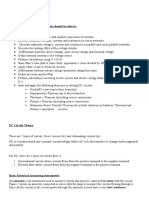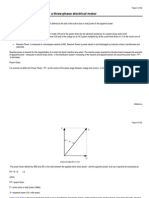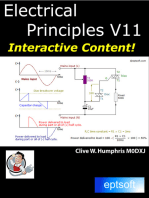Basic Electrical Concepts
Basic Electrical Concepts
Uploaded by
Raj Kumar PrajapatiCopyright:
Available Formats
Basic Electrical Concepts
Basic Electrical Concepts
Uploaded by
Raj Kumar PrajapatiOriginal Description:
Copyright
Available Formats
Share this document
Did you find this document useful?
Is this content inappropriate?
Copyright:
Available Formats
Basic Electrical Concepts
Basic Electrical Concepts
Uploaded by
Raj Kumar PrajapatiCopyright:
Available Formats
Take Print Zone4info - BASIC ELECTRICAL CONCEPTS
BASIC ELECTRICAL CONCEPTS
Posted by Hameedullah Ekhlas April 17
Basic electrical concepts In each plant, the mechanical movement of different equipments is caused by an electric prime mover (motor). Electrical power is derived from either utilities or internal generators and is distributed through transformers to deliver usable voltage levels. Electricity is found in two common forms: AC (alternating current) DC (direct current). Electrical equipments can run on either of the AC/DC forms of electrical energies. The selection of energy source for equipment depends on its application requirements. Each energy source has its own merits and demerits. Industrial AC voltage levels are roughly defined as LV (low voltage) and HV (high voltage) with frequency of 5060 Hz. An electrical circuit has the following three basic components irrespective of its electrical energy form: Voltage (volts) Ampere (amps) Resistance (ohms).
1. Voltage is defined as the electrical potential difference that causes electrons to flow.
2. Current is defined as the flow of electrons and is measured in amperes.
3. Resistance is defined as the opposition to the flow of electrons and is measured in ohms.
All three are bound together with Ohms law, which gives the following relation between the three:
V=IR (a) Power In DC circuits, power (watts) is simply a product of voltage and current. P =V I For AC circuits, the formula holds true for purely resistive circuits; however, for the following types of AC circuits, power is not just a product of voltage and current. Apparent power is the product of voltage and ampere, i.e., VA or kVA is known as apparent power. Apparent power is total power supplied to a circuit inclusive of the true and reactive power. Real power or true power is the power that can be converted into work and is measured in watts Reactive power If the circuit is of an inductive or capacitive type, then the reactive component consumes power and cannot be converted into work. This is known as reactive power and is denoted by the unit VAR. (b) Relationship between powers Apparent power (VA) = V A
True power (Watts) = VA cos
Reactive power (VAR) = VA sin
(c) Power factor Power factor is defined as the ratio of real power to apparent power. The maximum value it can carry is either 1 or 100(%), which would be obtained in a purely resistive circuit. Power factor = True power / Apparent power
You might also like
- Basic Electronics Terms and DefinitionsDocument7 pagesBasic Electronics Terms and Definitionspondu888No ratings yet
- Subject: 2es103 Basic Electrical Engineering (Bee)Document30 pagesSubject: 2es103 Basic Electrical Engineering (Bee)Jay SathvaraNo ratings yet
- TC-4.0 Fundamental of Electrical SystemDocument55 pagesTC-4.0 Fundamental of Electrical SystemRaziff CostaNo ratings yet
- Prelims Lecture Dash 3Document58 pagesPrelims Lecture Dash 3RONALDO OMBROGNo ratings yet
- UNIT I Electrical Circuits:: BE8253 Basic Electrical, Electronics and InstrumentationDocument16 pagesUNIT I Electrical Circuits:: BE8253 Basic Electrical, Electronics and InstrumentationBalu ChanderNo ratings yet
- Comparision of Ac & DCDocument11 pagesComparision of Ac & DCdevshakya885No ratings yet
- Power Factor PDFDocument14 pagesPower Factor PDFVictor SampaNo ratings yet
- Hindalco School of Excellence: Trainer: - Abhisek PagadDocument15 pagesHindalco School of Excellence: Trainer: - Abhisek PagadAbhisek PagadNo ratings yet
- Unit 1 DC Circuits Electrical Engineering Is The Field of Engineering That Generally Deals With The StudyDocument60 pagesUnit 1 DC Circuits Electrical Engineering Is The Field of Engineering That Generally Deals With The StudyAayush SinghNo ratings yet
- 2-Chapters Chapter 6 Electrical and Electromechanical Systems 2Document21 pages2-Chapters Chapter 6 Electrical and Electromechanical Systems 2Krushnasamy SuramaniyanNo ratings yet
- Power Factor: Definition and CalculationDocument2 pagesPower Factor: Definition and CalculationNtsh BglaNo ratings yet
- Electrical Engineering Interview QuestionDocument9 pagesElectrical Engineering Interview QuestionRohan BoseNo ratings yet
- Basics of Electrical System Training Slides 1691214327Document63 pagesBasics of Electrical System Training Slides 1691214327dastan989No ratings yet
- Chapter 2: DC Circuit TheoryDocument37 pagesChapter 2: DC Circuit TheoryTaonga NhambiNo ratings yet
- Conventional Current Electron Flow: Winkler, Basics of Electricity/Electronics Workshop, p.3Document1 pageConventional Current Electron Flow: Winkler, Basics of Electricity/Electronics Workshop, p.3sanshinde10No ratings yet
- Comparision of Ac & DCDocument11 pagesComparision of Ac & DCdevshakya885No ratings yet
- 13 Electrical Systems Slides 2023Document90 pages13 Electrical Systems Slides 2023Tarun Rana Rajdevar (Victoriasch)No ratings yet
- Solar Photovoltaic ReferenceDocument13 pagesSolar Photovoltaic ReferenceghershensoftNo ratings yet
- Ohms LawDocument24 pagesOhms LawVon MendozaNo ratings yet
- Telecommunications Wiring Clyde N Herrick 3rd Edition Chapter 1 PDFDocument24 pagesTelecommunications Wiring Clyde N Herrick 3rd Edition Chapter 1 PDFguimaNo ratings yet
- Mohamed Atef Mohamed Abdelrhman Arab (Report - 2) PDFDocument8 pagesMohamed Atef Mohamed Abdelrhman Arab (Report - 2) PDFdragon for pc gamesNo ratings yet
- Power Factor - WikipediaDocument81 pagesPower Factor - WikipediaTUTU OPHILIANo ratings yet
- Chap123 JazDocument12 pagesChap123 JazJasmine MonesNo ratings yet
- Module1 1Document46 pagesModule1 1Disha GoyalNo ratings yet
- Electric Templete AnswerDocument15 pagesElectric Templete Answerbelalebada25No ratings yet
- Bee Viva Prep.Document11 pagesBee Viva Prep.Pratik MishraNo ratings yet
- UNIT I NotesDocument34 pagesUNIT I NotesKarthikeyan VNo ratings yet
- Chapter 1Document5 pagesChapter 1kumalnimesh2No ratings yet
- Psoc Unit-1Document84 pagesPsoc Unit-1Shankar BhauNo ratings yet
- Review of Basic Circuit ConceptsDocument52 pagesReview of Basic Circuit ConceptsIsmail kabirNo ratings yet
- Engineering Utilities 1 Module 2Document13 pagesEngineering Utilities 1 Module 2harabassNo ratings yet
- Network Law and TheoremsDocument28 pagesNetwork Law and TheoremsBabee HaneNo ratings yet
- Chapter 2 DC Circuit TheoryDocument37 pagesChapter 2 DC Circuit TheoryTynoh MusukuNo ratings yet
- Electricity Theory Part 2Document17 pagesElectricity Theory Part 2Shaft SandaeNo ratings yet
- ELTA - Lecture 4 - Power in AC CircuitsDocument25 pagesELTA - Lecture 4 - Power in AC CircuitsMazwe HlafunaNo ratings yet
- Electrical Interview QuestionsDocument43 pagesElectrical Interview QuestionsAbbas JaveedNo ratings yet
- Current Electricity Chp-8 General Science 9th 10thDocument40 pagesCurrent Electricity Chp-8 General Science 9th 10thKamran AbdullahNo ratings yet
- ITC - Power Factor CorrectionDocument92 pagesITC - Power Factor Correctiongopir28No ratings yet
- Unit 1 DC Circuits Electrical Engineering Is The Field of Engineering That Generally Deals With The StudyDocument60 pagesUnit 1 DC Circuits Electrical Engineering Is The Field of Engineering That Generally Deals With The StudyAtharv BhedaNo ratings yet
- Engineering Utilities 1 Module 2Document14 pagesEngineering Utilities 1 Module 2harabassNo ratings yet
- Power Factor Definition For A ThreeDocument11 pagesPower Factor Definition For A ThreeMasroor Mahmud BrelviNo ratings yet
- Null 22Document254 pagesNull 22mohamed ibrahimNo ratings yet
- Single Phase AC FundamentalsDocument31 pagesSingle Phase AC FundamentalsShreyash SargarNo ratings yet
- Reactive Power Problems and System: Submitted By:-Section: - Roll No: - SubjectDocument16 pagesReactive Power Problems and System: Submitted By:-Section: - Roll No: - SubjectShubham AgrawalNo ratings yet
- Power Factor - WikipediaDocument11 pagesPower Factor - WikipediaMohamad SannanNo ratings yet
- Unidades 1,2,3Document10 pagesUnidades 1,2,3JR ALMANZARNo ratings yet
- Power Factor Correction ActualDocument34 pagesPower Factor Correction ActualKARAM ZAKARIA88% (8)
- 21Ees101T-Electrical and Electronicsengineering: Unit 1Document6 pages21Ees101T-Electrical and Electronicsengineering: Unit 1Femi RNo ratings yet
- Basic Electrical and Electronics Engineering: Course Code: BT 104Document24 pagesBasic Electrical and Electronics Engineering: Course Code: BT 104nehaNo ratings yet
- w2 BasicsDocument26 pagesw2 Basicsmurat aydoganNo ratings yet
- Chap3 - 1 Power Measurement PDFDocument22 pagesChap3 - 1 Power Measurement PDFTiffanyNo ratings yet
- PF 1Document5 pagesPF 1Ashish PatelNo ratings yet
- Basic Electronics Terms and DefinitionsDocument26 pagesBasic Electronics Terms and Definitionspondu888No ratings yet
- Chapter 1 - Basic Concepts in Electrical TechnologyDocument31 pagesChapter 1 - Basic Concepts in Electrical TechnologyDouglas OngomNo ratings yet
- BEEE Quick NotesDocument83 pagesBEEE Quick Notespriyazoe54No ratings yet
- Building Services Book 2Document237 pagesBuilding Services Book 2Africana RoyalNo ratings yet
- 45 - 6575 - EE231 - 2013 - 1 - 1 - 1 - EE 231 - Lect - 01Document18 pages45 - 6575 - EE231 - 2013 - 1 - 1 - 1 - EE 231 - Lect - 01athomeNo ratings yet
- Lecture 2-bDocument28 pagesLecture 2-bEslam SarwatNo ratings yet
- TestingDocument14 pagesTestingRaj Kumar PrajapatiNo ratings yet
- 220 KV Switchyard EquipmentsDocument3 pages220 KV Switchyard EquipmentsRaj Kumar Prajapati100% (1)
- Ohms LawDocument5 pagesOhms LawRaj Kumar PrajapatiNo ratings yet
- 220kV GIS Tech Spec - TrackDocument42 pages220kV GIS Tech Spec - Trackaravind_k104100% (1)
- Project Management 2: Chu Eu HoDocument44 pagesProject Management 2: Chu Eu HoGanesh BorkarNo ratings yet
- 400KV Substion AP TranscoDocument256 pages400KV Substion AP TranscoRaj Kumar PrajapatiNo ratings yet
- Service Manual: Hcd-Hpx9Document107 pagesService Manual: Hcd-Hpx9Lucas FerreiraNo ratings yet
- ABB - LV Capacitors - Power Factor Correction SolutionsDocument20 pagesABB - LV Capacitors - Power Factor Correction SolutionsAlecNo ratings yet
- IQ8Plus 72 M USDocument2 pagesIQ8Plus 72 M USImran KhanNo ratings yet
- Pulse Width Modulation Controlled DC Motor and H-BridgeDocument40 pagesPulse Width Modulation Controlled DC Motor and H-BridgeHarish Kumar70% (10)
- Fluid Kinematics: ENM3218/ENS6100: Fluid MechanicsDocument33 pagesFluid Kinematics: ENM3218/ENS6100: Fluid MechanicssatheeswaranNo ratings yet
- H8.Principles of FlightDocument48 pagesH8.Principles of FlightAF CSLNo ratings yet
- BATTERIESDocument27 pagesBATTERIESchintanpNo ratings yet
- 3.4 Submittal 4TTA3060Document2 pages3.4 Submittal 4TTA3060Deison F. Arango A.No ratings yet
- TS78L00 Series: Taiwan SemiconductorDocument12 pagesTS78L00 Series: Taiwan Semiconductorwallklock47No ratings yet
- Jiangsu Shuangdeng Group Co.,Ltd: ChinashotoDocument2 pagesJiangsu Shuangdeng Group Co.,Ltd: ChinashotoJose PinoNo ratings yet
- Project Title Metering Unit Process Datasheet: Date: Rev.: Ref. 1 / 4Document4 pagesProject Title Metering Unit Process Datasheet: Date: Rev.: Ref. 1 / 4anghel_florin82No ratings yet
- AP Physics 1 Algebra Based Unit 5 MomentumDocument7 pagesAP Physics 1 Algebra Based Unit 5 MomentumNikhita RajeshNo ratings yet
- Zelio: and To AssembleDocument20 pagesZelio: and To AssembleaavdNo ratings yet
- Jacket Water Heater With Pump: AttachmentsDocument5 pagesJacket Water Heater With Pump: AttachmentsMuhammad AwaisNo ratings yet
- UCA - BST.F.2019.18 (Assingment 01)Document11 pagesUCA - BST.F.2019.18 (Assingment 01)shehan harshithaNo ratings yet
- Shunt MotorDocument8 pagesShunt MotorCable PadcalNo ratings yet
- Converting VolumesDocument3 pagesConverting VolumesDevika TannaNo ratings yet
- MegaFlex - 480V UL UPS Brochure - 041720Document9 pagesMegaFlex - 480V UL UPS Brochure - 041720GeorgeNo ratings yet
- University of Cambridge International Examinations General Certificate of Education Advanced LevelDocument24 pagesUniversity of Cambridge International Examinations General Certificate of Education Advanced LevelHubbak KhanNo ratings yet
- European Conductor Stranding: Acc. To VDE 0295, IEC 60228, EN 60228Document2 pagesEuropean Conductor Stranding: Acc. To VDE 0295, IEC 60228, EN 60228AdrianNo ratings yet
- Caclation of Short CircuitDocument3 pagesCaclation of Short CircuitMohamed Mostafa100% (1)
- Hydraulic and Hydraulic MachinesDocument7 pagesHydraulic and Hydraulic MachinesAwanish PrajapatiNo ratings yet
- Datasheet 5A 180Khz 36V Buck DC To DC Converter Xl4015Document10 pagesDatasheet 5A 180Khz 36V Buck DC To DC Converter Xl4015araikNo ratings yet
- Service Manual: 21F-PA18 21F-PA18 (B) 21F-PD250 21F-PT220Document89 pagesService Manual: 21F-PA18 21F-PA18 (B) 21F-PD250 21F-PT220Kaokab Ibn Khaeruddin MNo ratings yet
- Grade 4 DLL Quarter 4 Week 5 (Sir Bien Cruz)Document48 pagesGrade 4 DLL Quarter 4 Week 5 (Sir Bien Cruz)Elmalyn BernarteNo ratings yet
- Design and Construction of Free Electricity GenerationDocument15 pagesDesign and Construction of Free Electricity Generationali purity100% (2)
- Evaluation of Photovoltaic Systems For Reactive Power Compensation in Low Voltage Power SystemsDocument6 pagesEvaluation of Photovoltaic Systems For Reactive Power Compensation in Low Voltage Power SystemsElkin Polo ArizaNo ratings yet
- Shriram Physics InvestigatoryDocument17 pagesShriram Physics Investigatorynappa saiyanNo ratings yet
- Electricity and MagnetismDocument450 pagesElectricity and Magnetismtxtanveer100% (3)






























































































